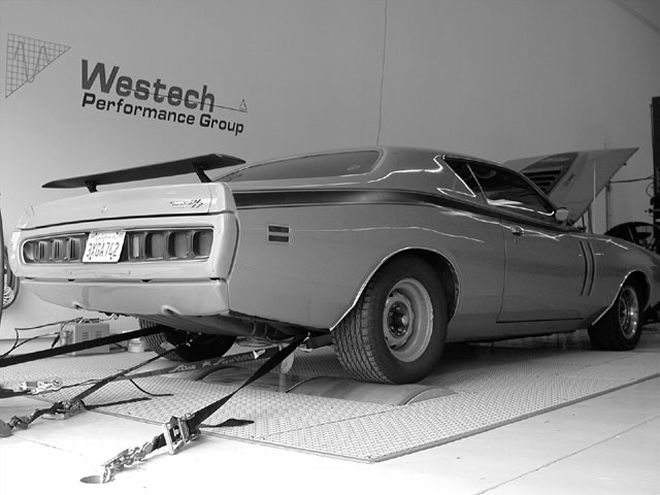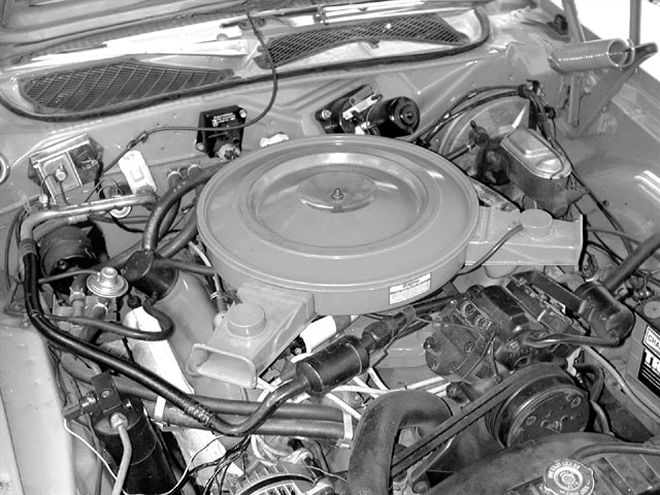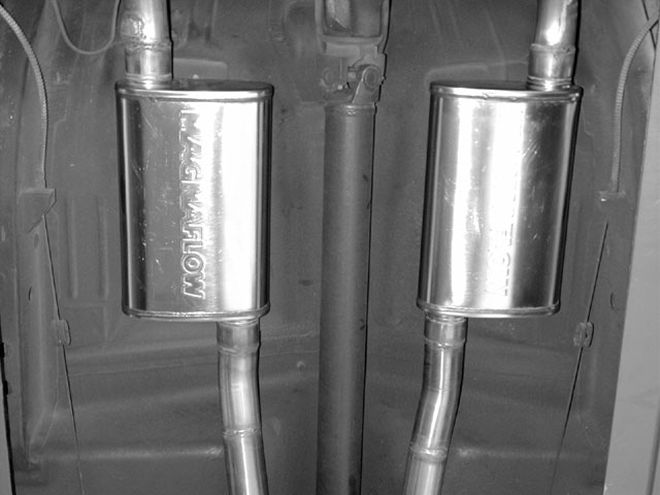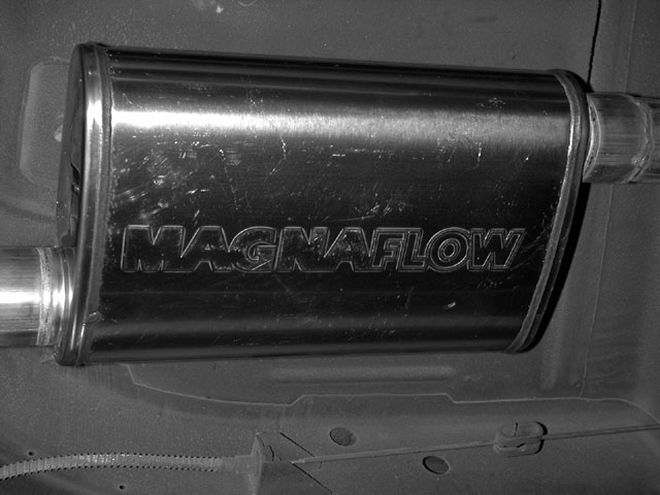
 What's a high-performance exhaust system really worth on a stock 440 car? We wondered, so we brought our Charger over to Westech to run some numbers.
What's a high-performance exhaust system really worth on a stock 440 car? We wondered, so we brought our Charger over to Westech to run some numbers.
We always considered the factory exhaust system fitted to Mopar musclecars as good. As factory systems of the era go, the OE Mopar exhaust was generally the best. Mopar iron manifolds were typically much better than the competition's, and the generous headpipes led to relatively quiet but free-breathing mufflers. For a while, the factory Mopar mufflers were among the most copied in the aftermarket, with many manufacturers marketing their version of the "Hemi" muffler. But as good as the factory system is, we were interested in evaluating how it performs against a modern aftermarket performance system.
Our testbed was a restored '71 Charger R/T sporting a 440 Magnum engine. Although the car had received some minor bolt-on mods in the past, we returned it to bone-stock condition for the evaluation. We wanted the baseline engine combination to be totally stock to match the totally stock exhaust system fitted to the car. From this base we would begin a series of modifications to the basic package and evaluate the performance increases step-by-step on the chassis dyno. Our first mod would be to upgrade the exhaust system with a set of headers and a free-breathing set of duals from MagnaFlow.
 Although the Charger engine had previously been modified with some minor bolt-ons, we returned it to pure-stock form for our testing purposes. Output measured at the rear wheels stood at 252 hp.
Although the Charger engine had previously been modified with some minor bolt-ons, we returned it to pure-stock form for our testing purposes. Output measured at the rear wheels stood at 252 hp.
We contacted Hooker for its PN 5903 metallic-ceramic coated Competition headers to replace the factory manifolds. Hooker markets two series of headers-the Competition and Super Competition lines. The Super Comps are made for lighter weight and closely matched primary tube lengths, and come with a higher price tag. For a street application, the Comp header's weight penalty is a worthwhile trade for the heavier-tube construction. The PN 5903 header features 1 7/8-inch primary tubes and 3-inch collectors. That's more than enough header to handle a big-block Mopar in the mid-500hp range, but not so large that low-end response and fit are compromised. For the exhaust system, we handed the car to the exhaust experts at MagnaFlow.
For our dyno evaluation, we took the Charger to the chassis dyno facility at Westech Performance Group to get our baseline numbers. The stock 440 delivered 252.0 hp at 4,200 rpm at the rear wheels, while torque came in at 365.3 lb-ft at 3,200 rpm. The numbers were in the range we are used to seeing for a stock 440.
The Mods
We pulled the car off the rollers and directly onto the lift to remove the stock exhaust system. The Hooker headers went in with little trouble and no modifications or tube dimpling. The most difficult part of the header installation was removing the stock exhaust-manifold mounting studs, which can be stubborn. The tubes cleared the power steering and tucked nicely in the chassis. We were pleased with the fit. With the headers bolted in, we temporarily mounted a set of header-mount glasspacks for the drive to MagnaFlow's facilities.
MagnaFlow manufactures universal exhaust-system components as well as partial and complete systems for specific applications. The company does not market a prefabricated system for early Mopar applications, but it works with hundreds of authorized installation centers across the country which carry the MagnaFlow line of exhaust products. We brought the Charger to MagnaFlow's main tech center, where products and installations are prototyped, installed, and tested. Although our system was installed at the tech center, similar systems are routinely custom-fabricated through their many authorized dealers. We basically gave the crew at MagnaFlow full discretion to build a system to fit our requirements.
 The PN 14336 mufflers are a more compact design than the stockers, and easily fit in the original location under the floorpan.
The PN 14336 mufflers are a more compact design than the stockers, and easily fit in the original location under the floorpan.
The new system was built around a pair of MagnaFlow PN 14336 4x9-inch oval-body stainless steel mufflers with welded end caps. These mufflers feature a 2 1/2-inch offset inlet and outlet with a case length of 14 inches. Sound dampening is provided by a straight-through, perforated stainless steel core wrapped with a stainless steel mesh. The case is also filled with an acoustical suppression material. There are no chambers, baffles, or louvers in the MagnaFlow straight-through design. According to the company, the result is greatly improved flow when compared to the OE-style mufflers previously fitted to our Charger.
The system was fabricated from stainless steel, pre-bent tube sections, which were cut and welded to fit the Charger's chassis. The mandrel-bent tubing maintains its cross-sectional area through the curved section of pipe, offering better flow than like-sized tubing formed through conventional compression bends. The layout of the MagnaFlow system was in the traditional, separated dual-exhaust configuration as our car was originally equipped. MagnaFlow also has universal "X" pipes which can be incorporated into the system, although ours was fabricated with no crossover between the banks. The 2 1/2-inch headpipes lead into the polished stainless mufflers, then continue over the rear axle assembly to terminate with a pair of 3 1/2-inch slash cut tips at the stock rear valance cutout. We were impressed with the workmanship.
 We went to MagnaFlow's tech center to have a new system-based upon its straight-through PN 14336 2 1/2-inch stainless mufflers-installed.
We went to MagnaFlow's tech center to have a new system-based upon its straight-through PN 14336 2 1/2-inch stainless mufflers-installed.
When we returned to MagnaFlow, we were anxious to fire up the Charger and evaluate the new system. With a spin of the starter, the car fired and settled into a mildly throaty rumble at idle. Nailing it through First gear on the industrial road outside the tech center, the exhaust tone could be described as an angry growl. At WOT, the full straight-through flow definitely gets your attention as the 440 under the hood does its work. Settling into a cruise, the dampening of the mufflers tame the exhaust's energy for a mellow but powerful sound. Absent is the battering, low-frequency drone and resonance of some high-flow mufflers. Likewise, at idle we appreciated the lack of a rattling resonance that comes as part of the territory with some other performance mufflers. We had a powerful sound, and the performance promise of a straight-through design, but the dyno evaluation would be the last word on whether there was any real performance to be had over the stock system.
Although MagnaFlow's tech center is equipped with a state-of-the-art dyno facility, we returned to Westech for our testing in order to avoid variations in dyno calibration. When John Baechtel at Westech guided the Charger back onto his SuperFlow dyno, onlookers commented on the powerful tone. It was hard to remember the engine is all stock. Would we find the bite to go with the bark? We soon had the answer, with 280.0 hp at 4,450 rpm and 390.1 lb-ft of torque at 3,150 rpm. The power curve was up across the board-impressive, since sometimes performance mods gain in one area of the rpm range and can cost some power at the other end. The exhaust system alone was worth a substantial increase of 11 percent in peak power output. More importantly for us, we now have an exhaust system that is capable of handling extensive engine modifications to come.
Chassis Dyno Results
Superflow Chassis Dyno
'71 Charger R/T; Stock 440 MagnumTorqueTorqueHpHpRPMStockModifiedStockModified2,800292.3353.9152.6188.93,000355.2388.8202.7223.03,500356.8382.9237.6256.24,000324.7359.4247.2273.54,500287.8323.4246.2277.55,000241.3279.7229.9266.25,500171.1220.6179.3231.5